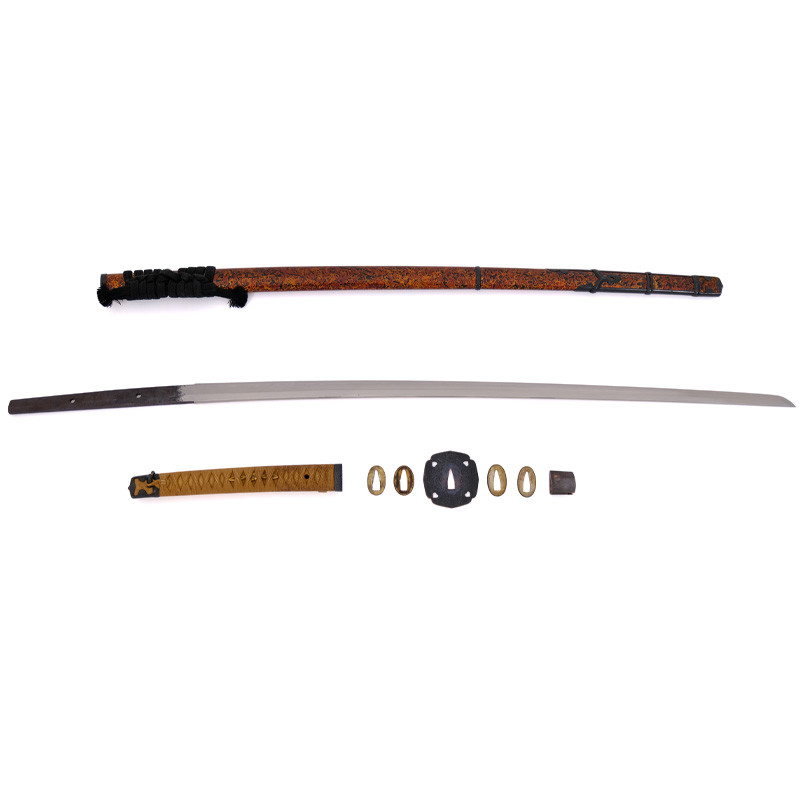




















More informations about this product
| Total Weight | 1.671 kg | |
| Weight without Saya | 1.363 kg | |
| Blade Weight | 0.998 kg | |
| Full Blade length (Toshin) | 109.30 cm | |
| Nagasa | 83.60 cm | |
| Nakago Length | 25.6 cm | |
| Sori (curvature) | 1.20 cm | |
| Kissaki Length | 2.10 cm | |
| Moto Haba | 3.05 cm | |
| Saki Haba | 1.71 cm | |
| Moto Kasane | A = 0.79 cm B = 0.80 cm |
|
| Saki Kasane | A = 0.41 cm B = 0.45 cm |
|
| Curvature | Tori Zori | |
| Type Kissaki | Ko Kissaki | |
| Blade Structure | Shinogi Zukuri (diamond shaped) | |
| Mune | Iori Mune (triangular) | |
| Hamon | Midare Suguha in Nie | |
| Hada | fine Itame | |
| Boshi | Ko maru | |
| Nakago | Signed on the face Omote 近江守藤原継平 ‘Omi no kami Fujiwara Tsuguhira’, Suriage Machi Okuri (shortened), 4 Mekugi Ana including 2 patched up, Classical Futsu Gata shape, Yasurime Katte Sagari (lighty oblique), Nakago Jiri Ha Agari Kurijiri (dyssimetric U) | |
| Saya | Length 88cm, weight 307g, Very beautiful and elegant Tsugaru Nuri lacquer type Kara Nuri, with black cotton sageo. Saya of the Handachi type, with reinforcements (Koi Guchi, Seme Gane, Ishizuki) in Shakudo with the ivy (or vine) pattern of the Karakusa type. | |
| Tsuka & Tosogu (Tsuba, Menuki, Fuchi Kashira) |
- Tsuka: Length 28.8cm, Weight 145g, Braiding Tsumami Maki in beige silk, Same white, Mounting's Kashira Handachi (Kabuto Gane) and Fuchi in Shakudo in ivy (or vine) pattern type Karakusa, Menuki in Shakudo golden rabbit design with large elongated ears. The rabbit is a symbol of dedication and intelligence, but also of love and healing. - Tsuba : Dimensions 7.61x7.97x0.49 cm, weight 163g, Aoi Gata shape with 4 boar eye openings (Shihô inomesukashi), Shakudo patina (bluish black), golden border, ivy pattern (or vine) type Karakusa. - Habaki: Weight 32g, patinated copper type Shakudo, Nekogaki type Yujo - Seppa: Set of 4 Seppa made of brass and copper (Total weight 22g) |
|
| Study & Team Review |
Tsuguhira 継 平 1st generation, of his civil name ‘Fujita Yohei’, was from the province of Echizen 越 前. He lived in the second half of the 17thth century, circa 1680. He was a student of Yasutsugu 2th gen (or 3th according to the sources), which he inherited from the Kanji «Tsugu» 継. He then settled in the capital Edo and forged in the lineage of his master, using Nanban-Tetsu (foreign steel) with a very good quality of Jigane. It is classified Wazamono, distinction from the good cutting edge quality of its blades.
|
|
Share your opinion
error Your review appreciation cannot be sent
feedback Report comment
check_circle Report sent
error Your report cannot be sent